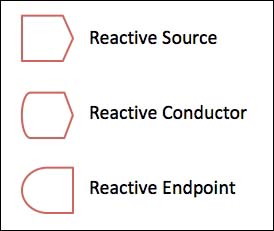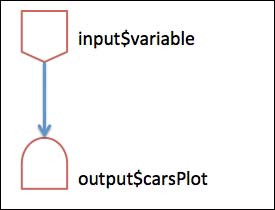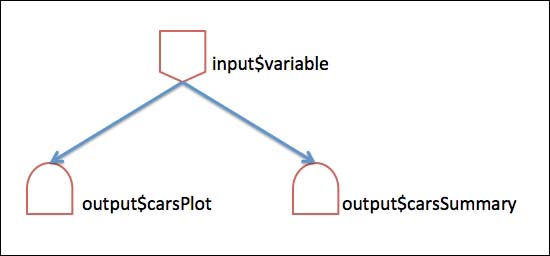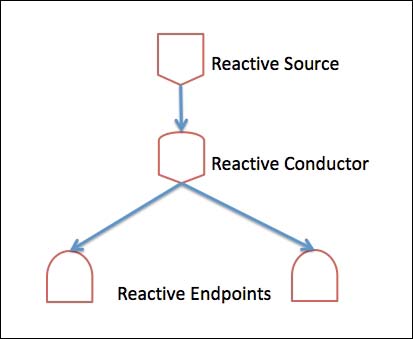Shiny uses a reactive programming model, and this is a big deal. By applying reactive programming, the framework is able to be fast, efficient, and robust. Briefly, changing the input in the user interface, Shiny rebuilds the related output. Shiny uses three reactive objects:
- Reactive source
- Reactive conductor
- Reactive endpoint
For simplicity, we use the formal signs of the RStudio documentation:

The implementation of a reactive source is the reactive value; that of a reactive conductor is a reactive expression; and the reactive endpoint is also called the observer.
As taught in the previous section, the defined input of the ui.R links is the output of the server.R file. For simplicity, we use the code from our first Shiny app again, along with the introduced formal signs:
...
output$carsPlot <- renderPlot({
hist(mtcars[,input$variable],
main = "Histogram of mtcars variables",
xlab = input$variable)
})
...
The input variable, in our app these are the Horsepower; Miles per Gallon, and Number of Carburetors choices, represents the reactive source. The histogram called carsPlot stands for the reactive endpoint. In fact, it is possible to link the reactive source to numerous reactive endpoints, and also conversely. In our Shiny app, we also connected the input variable to our first and second output—carsSummary:
...
output$carsPlot <- renderPlot({
hist(mtcars[,input$variable],
main = "Histogram of mtcars variables",
xlab = input$variable)
})
output$carsSummary <- renderPrint({
summary(mtcars[,input$variable])
})
...
To sum it up, this structure ensures that every time a user changes the input, the output refreshes automatically and accordingly.
The reactive conductor differs from the reactive source and the endpoint is so far that this reactive type can be dependent and can have dependents. Therefore, it can be placed between the source, which can only have dependents and the endpoint, which in turn can only be dependent. The primary function of a reactive conductor is the encapsulation of heavy and difficult computations. In fact, reactive expressions are caching the results of these computations. The following graph displays a possible connection of the three reactive types:

In general, reactivity raises the impression of a logically working directional system; after input, the output occurs. You get the feeling that an input pushes information to an output. But this isn't the case. In reality, it works vice versa. The output pulls the information from the input. And this all works due to sophisticated server logic. The input sends a callback to the server, which in turn informs the output that pulls the needed value from the input and shows the result to the user. But of course, for a user, this all feels like an instant updating of any input changes, and overall, like a responsive app's behavior. Of course, we have just touched upon the main aspects of reactivity, but now you know what's really going on under the hood of Shiny.